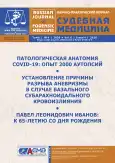Использование метода компьютерной томографии при судебно-медицинской идентификации личности
- Авторы: Леонов С.В.1,2, Шакирьянова Ю.П.1,2
-
Учреждения:
- ФГКУ «111 Главный государственный центр судебно-медицинских и криминалистических экспертиз» Министерства обороны Российской Федерации
- ФГБОУ ВО «Московский государственный медико-стоматологический университет имени А.И. Евдокимова» Минздрава России
- Выпуск: Том 6, № 4 (2020)
- Страницы: 41-45
- Раздел: В помощь судебно-медицинскому эксперту
- URL: https://journal-vniispk.ru/2411-8729/article/view/122418
- DOI: https://doi.org/10.19048/fm339
- ID: 122418
Цитировать
Полный текст
Аннотация
Актуальность. В статье представлен собственный опыт применения данных компьютерной томографии при идентификации личности с заведомо известными результатами.
Цель исследования — проверка возможности выполнения идентификационного исследования по трёхмерной модели, полученной из данных компьютерной томографии головы. Идентификация проводилась по трёхмерной модели головы, построенной на основании срезов компьютерной томографии, выполненных в различных проекциях с шагом 1,23–1,25 мм. Для сравнения использовались двухмерные изображения лица (фотографии). Все сравнительные исследования проводились с использованием утверждённых методик краниофациальной и портретной идентификации — по реперным точкам и контурам. В рамках эксперимента использовались компьютерная программа, позволяющая экспортировать DICOM-файлы результатов компьютерной томографии в другие форматы (InVesalius), а также компьютерные программы, в которых непосредственно осуществлялась работа с объектами исследования (Autodesk 3ds Max, альтернативные программы Adobe Photoshop, Smith Micro Poser Pro).
Результаты. В ходе исследований установлено, что данные компьютерной томографии головы позволяют проводить идентификационные исследования по таким параметрам, как реконструированная трёхмерная модель мягких тканей лица, трёхмерная модель черепа (краниофациальная идентификация), особенности строения ушной раковины.
Заключение. При сопоставлении объектов получены положительные результаты, что делает целесообразным применение трёхмерной модели в рамках практической и научной деятельности.
Ключевые слова
Полный текст
Открыть статью на сайте журналаОб авторах
Сергей Валерьевич Леонов
ФГКУ «111 Главный государственный центр судебно-медицинских и криминалистических экспертиз» Министерства обороны Российской Федерации; ФГБОУ ВО «Московский государственный медико-стоматологический университет имени А.И. Евдокимова» Минздрава России
Email: sleonoff@inbox.ru
ORCID iD: 0000-0003-4228-8973
д.м.н., профессор
Россия, Москва; МоскваЮлия Павловна Шакирьянова
ФГКУ «111 Главный государственный центр судебно-медицинских и криминалистических экспертиз» Министерства обороны Российской Федерации; ФГБОУ ВО «Московский государственный медико-стоматологический университет имени А.И. Евдокимова» Минздрава России
Автор, ответственный за переписку.
Email: tristeza_ul@mail.ru
ORCID iD: 0000-0002-1099-5561
к.м.н.
Россия, 105094, Москва, Госпитальная площадь, д. 3; МоскваСписок литературы
- Абрамов А.С. Использование прижизненных рентгенографических изображений головы и зубочелюстного аппарата при проведении идентификации личности: автореф. дис. … канд. мед. наук. Москва, 2012. Режим доступа: https://search.rsl.ru/ ru/record/01005046532. Дата обращения: 12.10.2020.
- Ковалев А.В. Идентификация личности по особенностям строения грудной клетки и позвоночника: рентгенологическое и судебно-медицинское исследование: автореф. дис. … докт. мед. наук. Санкт-Петербург, 1997. Режим доступа: https://search.rsl.ru/ru/record/01000029337. Дата обращения: 12.10.2020.
- Карпова Г.Н. Идентификация личности по комплексному исследованию особенностей строения зубов и зубных рядов: дис. … канд. мед. наук. Москва, 2004. Режим доступа: https://search.rsl.ru/ru/record/01004065943. Дата обращения: 12.10.2020.
- Эюбов У.Г. Исследование ангулярных признаков зубов и зубных рядов применительно к целям идентификации личности: автореф. дис. … канд. мед. наук. Москва, 2005. Режим доступа: https://search.rsl.ru/ru/record/01003039865. Дата обращения: 12.10.2020.
- Горшков А.Н. Индивидуальные особенности лобных пазух как критерий идентификации личности: автореф. дис. … канд. мед. наук. Санкт-Петербург, 2003. Режим доступа: https://search.rsl.ru/ru/record/01002325938. Дата обращения: 12.10.2020.
- Неклюдов Ю.А. Рентгеноанатомическое исследование половых, возрастных и индивидуальных особенностей дистальных фаланг кисти в судебно-медицинском отношении: автореф. дис. … канд. мед. наук. Москва, 1969. Режим доступа: https://search.rsl.ru/ru/record/01007186002. Дата обращения: 12.10.2020.
- Пойлов С.А., Овчинников О.Б., Япаров С.С., Фейгин А.В. Использование прижизненных рентгенограмм для идентификации личности человека // Проблемы экспертизы в медицине. 2001. Т. 1, № 2. С. 42–43.
- Клевно В.А., Чумакова Ю.В. Виртопсия — новый метод исследования в отечественной практике судебной медицины // Судебная медицина. 2019. № S1. С. 46.
- Meisenzahl M. Facial-recognition software is now so advanced that it can identify you only from an MRI scan of your brain, a new study reveals. 2019. Available from: https://www.businessinsider.com/facial-recognition-software-identifies-patients-from-mri-brain-scan-study-2019-10.
- Дадабаев В.К., Стрельников В.Н., Стрельников Е.В. Идентификация человека методом рентгенологической компьютерной томографии // Международный научно-исследовательский журнал. 2015. Т. 9, № 40. С. 19–27.
- Ковалев А.В., Аметрин М.Д., Золотенкова Г.В., и др. Судебно-медицинское установление возраста по КТ-сканограммам черепа и краниовертебральной области в сагиттальной проекции // Судебно-медицинская экспертиза. 2018. № 1. С. 21–27.
- Леонов С.В., Крупин К.Н., Петров В.В. Особенности морфологии переломов большеберцовых костей, причиненных выстрелом в упор многокомпонентным пулевым травматическим зарядом 12-го калибра, с установленным методом математического моделирования механизмом их формирования // Вестник судебной медицины. 2017. Т. 3, № 6. С. 9–15.
- Абрамов С.С. Компьютеризация краниофациальной идентификации: методология и практика: автореф. дис. … докт. мед. наук. Москва, 1998. Режим доступа: https://search.rsl.ru/ ru/record/01000213188. Дата обращения: 12.10.2020.
- Зинин А.М., Кирсанова Л.З. Криминалистическая фотопортретная экспертиза: Учебное пособие / под ред. В.А. Снеткова, З.И. Кирсанова. Москва: ВНКЦ МВД СССР, 1991.
- Шакирьянова Ю.П., Леонов С.В., Пинчук П.В. Метод краниофациальной идентификации с использованием программного обеспечения «3 ds Max» и «AgisoftPhotoscan». Москва: Мозартика, 2019.
- Шакирьянова Ю.П., Леонов С.В., Пинчук П.В. Опыт усовершенствования метода краниофациальной диагностики при решении идентификационных задач // Медицинская экспертиза и право. 2017. № 1. С. 15–18.
- Шакирьянова Ю.П., Леонов С.В. Портретная экспертиза с применением трёхмерного моделирования // Судебная медицина. 2019. № S1. С. 165.
Дополнительные файлы










